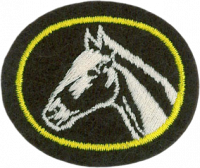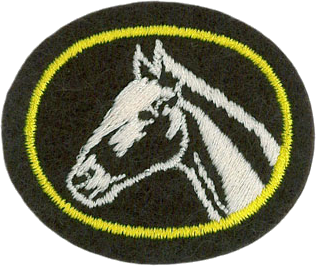Difference between revisions of "AY Honors/Horse Husbandry/Answer Key/es"
From Pathfinder Wiki
< AY Honors | Horse HusbandryAY Honors/Horse Husbandry/Answer Key/es
(Created page with "</noinclude>") |
(Updating to match new version of source page) |
||
| (3 intermediate revisions by 2 users not shown) | |||
| Line 1: | Line 1: | ||
| − | + | {{HonorSubpage}} | |
| − | |||
| − | {{ | ||
| − | |||
| − | |||
| − | |||
| − | |||
| − | |||
| − | |||
| − | |||
| − | }} | ||
| − | |||
| − | |||
| − | |||
<section begin="Body" /> | <section begin="Body" /> | ||
{{ansreq|page={{#titleparts:{{PAGENAME}}|2|1}}|num=1}} | {{ansreq|page={{#titleparts:{{PAGENAME}}|2|1}}|num=1}} | ||
| Line 32: | Line 19: | ||
{{ansreq|page={{#titleparts:{{PAGENAME}}|2|1}}|num=2}} | {{ansreq|page={{#titleparts:{{PAGENAME}}|2|1}}|num=2}} | ||
<noinclude></noinclude> | <noinclude></noinclude> | ||
| − | <!-- 2. | + | <!-- 2. ¿Por qué es preferible criar potros de raza pura en lugar de raza común? --> |
| − | |||
<noinclude></noinclude> | <noinclude></noinclude> | ||
| Line 39: | Line 25: | ||
{{ansreq|page={{#titleparts:{{PAGENAME}}|2|1}}|num=3}} | {{ansreq|page={{#titleparts:{{PAGENAME}}|2|1}}|num=3}} | ||
<noinclude></noinclude> | <noinclude></noinclude> | ||
| − | <!-- 3. | + | <!-- 3. Mencionar al menos cinco puntos que son deseables en la selección de un caballo. --> |
| − | |||
| − | |||
| − | |||
| − | |||
| − | |||
<noinclude></noinclude> | <noinclude></noinclude> | ||
| Line 50: | Line 31: | ||
{{ansreq|page={{#titleparts:{{PAGENAME}}|2|1}}|num=4}} | {{ansreq|page={{#titleparts:{{PAGENAME}}|2|1}}|num=4}} | ||
<noinclude></noinclude> | <noinclude></noinclude> | ||
| − | <!-- 4. | + | <!-- 4. ¿Qué clase de capacitación ayudará al criar potros para convertirse en caballos dóciles y fiables? --> |
| − | |||
{{clear}} | {{clear}} | ||
| − | {{clear}} | + | {{clear}} |
{{clear}} | {{clear}} | ||
| Line 65: | Line 45: | ||
{{ansreq|page={{#titleparts:{{PAGENAME}}|2|1}}|num=5}} | {{ansreq|page={{#titleparts:{{PAGENAME}}|2|1}}|num=5}} | ||
<noinclude></noinclude> | <noinclude></noinclude> | ||
| − | <!-- 5. | + | <!-- 5. Describir el buen cuidado y alimentación de los caballos y decir tres tipos diferentes de alimentos para caballos. --> |
| − | |||
| − | |||
| − | |||
| − | |||
{{clear}} | {{clear}} | ||
| Line 89: | Line 65: | ||
{{ansreq|page={{#titleparts:{{PAGENAME}}|2|1}}|num=6}} | {{ansreq|page={{#titleparts:{{PAGENAME}}|2|1}}|num=6}} | ||
<noinclude></noinclude> | <noinclude></noinclude> | ||
| − | <!-- 6. | + | <!-- 6. Conocer los siguientes términos: --> |
<noinclude></noinclude> | <noinclude></noinclude> | ||
{{ansreq|page={{#titleparts:{{PAGENAME}}|2|1}}|num=6a}} | {{ansreq|page={{#titleparts:{{PAGENAME}}|2|1}}|num=6a}} | ||
| Line 109: | Line 85: | ||
{{ansreq|page={{#titleparts:{{PAGENAME}}|2|1}}|num=7}} | {{ansreq|page={{#titleparts:{{PAGENAME}}|2|1}}|num=7}} | ||
<noinclude></noinclude> | <noinclude></noinclude> | ||
| − | <!-- 7. | + | <!-- 7. Saber cómo poner correctamente un cabestro, brida y silla en un caballo. --> |
{{clear}} | {{clear}} | ||
| Line 119: | Line 95: | ||
{{ansreq|page={{#titleparts:{{PAGENAME}}|2|1}}|num=8}} | {{ansreq|page={{#titleparts:{{PAGENAME}}|2|1}}|num=8}} | ||
<noinclude></noinclude> | <noinclude></noinclude> | ||
| − | <!-- 8. | + | <!-- 8. Conocer cómo cuidar de forma adecuada los cascos (pezuña) de un caballo. Conocer las partes de la pezuña. --> |
| − | |||
{{clear}} | {{clear}} | ||
| Line 132: | Line 107: | ||
{{clear}} | {{clear}} | ||
| − | {{clear}} | + | {{clear}} |
{{clear}} | {{clear}} | ||
| Line 144: | Line 119: | ||
{{ansreq|page={{#titleparts:{{PAGENAME}}|2|1}}|num=9}} | {{ansreq|page={{#titleparts:{{PAGENAME}}|2|1}}|num=9}} | ||
<noinclude></noinclude> | <noinclude></noinclude> | ||
| − | <!-- 9. | + | <!-- 9. Atender un potro o un caballo por lo menos una semana. --> |
| − | |||
{{clear}} | {{clear}} | ||
| Line 156: | Line 130: | ||
{{CloseReq}} <!-- 9 --> | {{CloseReq}} <!-- 9 --> | ||
<noinclude></noinclude> | <noinclude></noinclude> | ||
| − | == | + | ==Referencias== |
| − | |||
| − | |||
| − | |||
| − | |||
| − | |||
| − | |||
<noinclude></noinclude> | <noinclude></noinclude> | ||
| − | + | {{CloseHonorPage}} | |
| − | |||
Latest revision as of 17:39, 14 July 2022
Cría de caballos
Nivel de destreza
1
Año
1944
Version
23.05.2024
Autoridad de aprobación
Asociación General
1
¿Qué línea de beneficio se deriva de la utilización de yeguas especialmente seleccionadas?
2
¿Por qué es preferible criar potros de raza pura en lugar de raza común?
3
Mencionar al menos cinco puntos que son deseables en la selección de un caballo.
4
¿Qué clase de capacitación ayudará al criar potros para convertirse en caballos dóciles y fiables?
5
Describir el buen cuidado y alimentación de los caballos y decir tres tipos diferentes de alimentos para caballos.
6
Conocer los siguientes términos:
6a
Cabestro
6b
Brida
6c
Silla de montar
7
Saber cómo poner correctamente un cabestro, brida y silla en un caballo.
8
Conocer cómo cuidar de forma adecuada los cascos (pezuña) de un caballo. Conocer las partes de la pezuña.
9
Atender un potro o un caballo por lo menos una semana.


